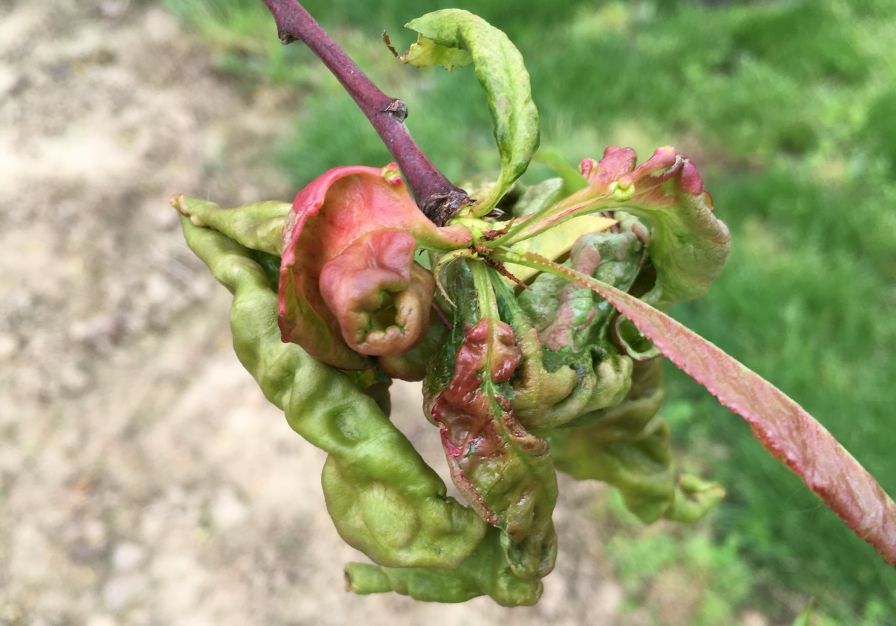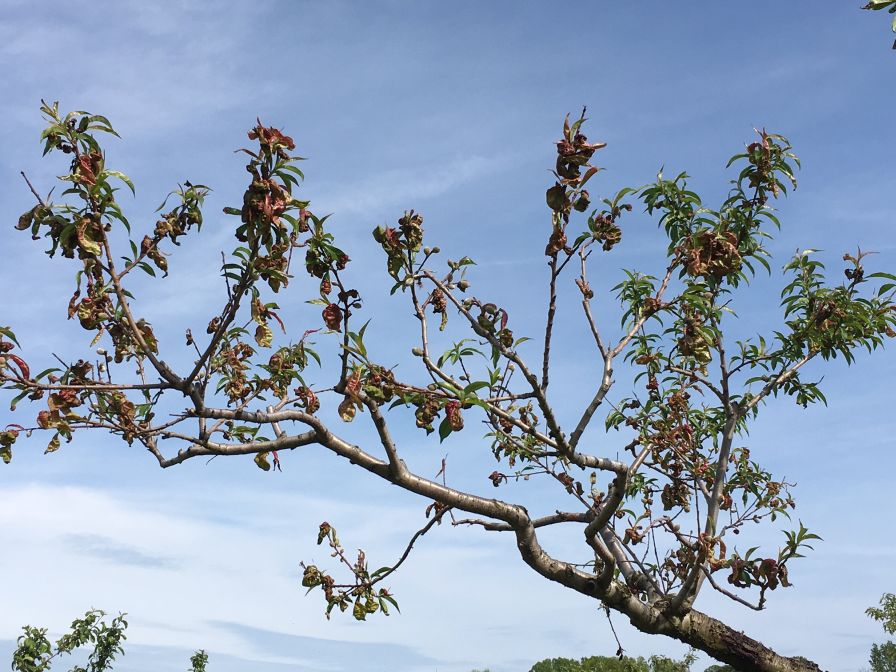Keep an Eye out for Peach Leaf Curl

The color of leaves showing peach leaf curl symptoms can vary from shades of green and yellow to pink, orange, and purple. (Photo: Kari Peter)
This year, peach leaf curl caught many Pennsylvania growers off guard. Once symptoms are seen, it’s too late to do anything.
Peach leaf curl is caused by the fungus Taphrina deformans and occurs wherever peaches are grown. The fungus causes the growing cells at the leaf margins to multiply quickly and randomly, which results in the puckered, curled, distorted appearance. Often, the color of the leaves varies from shades of green and yellow to pink, orange, and purple. Spores are produced on the surface of the leaf as the leaf matures, giving it a dusty appearance. Fruit can be infected and will either drop prematurely or form distortions on the surface.
The spores overwinter in bark crevices and around the buds. Primary infection occurs from bud swell until the first leaves fully emerge. Rains wash the spores into the buds and long periods of cool (50°F to 70°F), wet (>95% humidity) weather are ideal for infection; little infection occurs below 45°F. If warm temperatures follow bud swell and leaf development is rapid, infections are rarely established, even if rains occur. Considering how our spring progressed with cool, wet weather, this year is officially “peach leaf curl” year in many parts of Pennsylvania.
If I see symptoms, can I still treat for the disease?
Treating the disease after symptom development is not effective since the leaves are protecting the spores around the buds. If folks are observing leaf curl in their peach trees they will have to wait until the end of the season to manage the disease. If leaf curl is severe this season, it is important to maintain tree vigor by thinning more fruit than normal, irrigate to reduce drought stress, and apply extra nitrogen fertilizer.
I applied a fungicide spray during dormancy. Why am I still seeing leaf curl?

Peach leaf curl spores are produced on the surface of the leaves as the leaf matures, giving it a dusty appearance. (Photo: Kari Peter)
This winter was a very crazy winter. We had 70ºF days in February and 20ºF days in the latter half of March. For folks who applied their “dormant” fungicide spray on their peaches after the 70ºF days in February, this might be your issue. If any kind of bud swell occurred in February due those very warm days, the peach leaf curl fungal spores most likely were protected when a dormant fungicide spray was applied later. When the spores are protected, there is not much you can do. The early varieties of peaches seem to be most affected by leaf curl this year, and Mother Nature is most likely to blame for the lack of efficacy of fungicide sprays this winter.
How can I effectively manage peach leaf curl in the future?
For folks who are really suffering, I would recommend a fungicide spray in the late fall and late winter/early spring to be able to effectively manage the disease. Growers must wait until at least 90% of the leaves have fallen in the fall or in the spring before bud swell for controlling the disease. During this time, applying a fungicide (chlorothalonil) or copper spray is appropriate. All cultivars are susceptible to leaf curl to some degree, although ‘Redhaven’ and cultivars derived from ‘Redhaven’ are more resistant.
For future seasons, growers will have to monitor the temperatures closely in February. If above average temperatures are in the forecast, it would behoove folks to apply their late winter/early spring dormant fungicide spray prior to those warm temperatures to effectively control the fungus hanging around the buds.









